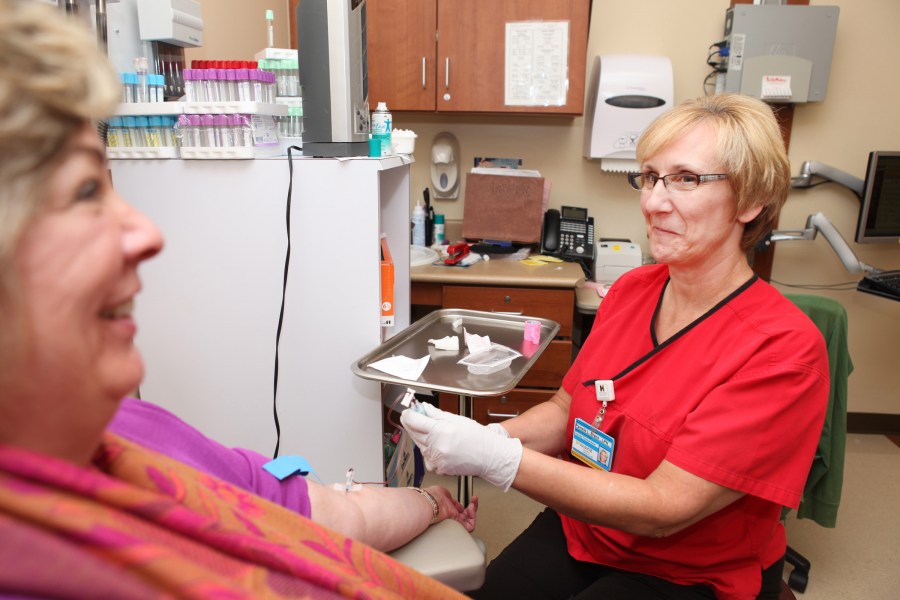
Pam Brace, LPN, works with patient Kim Bass at the Vanderbilt Breast Center and Medical Infusion Clinic. (photo by Susan Urmy)
Communication drives coordination at Breast Center
The Vanderbilt Breast Center and Medical Infusion Clinic are models of shared governance and effective communication, and provide a strong example of why the Medical Center is worthy of a second Magnet designation.
The Breast Center, with a staff of 11 nurses, sees at least 200 patients a day for clinical care and imaging of breast health issues. The Infusion Clinic, with 9 nurses, has 16 rooms for outpatient intravenous therapy.

“We have a truly multi-disciplinary shared governance model,” said Sheryl Redlin-Frazier, R.N., MSN, manager of patient care services. “Everyone’s input is encouraged and honored, and it really drives everything we do.”
Nurses are included in every group that meets and often outnumber other practitioners present.
Perhaps the most important meetings center around patient flow. The Breast Center and Infusion Clinic are both located at One Hundred Oaks but are on different sides of the facility, which can make communication and coordination difficult.
“The Infusion Center charge nurse comes to the Breast Center every morning for a ‘huddle’ to check the flow of the chemo system. There are often multiple orders and we have to make sure they’re all in line with each other,” said Andrea Whitis, R.N., B.S.
In addition, every Friday a team meets to ensure the upcoming week’s schedule is coordinated – if patients have all the appointments they need on the schedule, and the pharmacy has the necessary chemicals and capacity to mix the chemotherapy, for example.
“It has led to shorter wait times, less dissatisfaction and more attention given to our patients by providers,” Redlin-Frazier said.
With an increased focus on communication and coordination, the Breast Center and Infusion Clinic can offer more convenience to patients.
“Our clinic has a unique quality because all the services are right here. A woman can come for a routine screening, and if a problem is found, have a diagnostic exam. If we diagnose a problem, she can see a provider. All of that is in the same place and often in the same day,” Redlin-Frazier said.
“What’s great about the Breast Center is our dedicated MRI machine,” added Pam Wood, R.N., BSN. “If a patient needs an MRI, we can often add them on and they don’t have to make a visit back later. We also have medical and surgical oncology under one roof, which is so much better for continuity of care.”
Nurses at the Breast Center and Infusion Clinic emphasize that underlying all these meetings, huddles and schedules is an intense focus on providing the best patient care.
“The driving force is our patient,” Redlin-Frazier said. “Everyone in the group will ask if we are doing what’s right for the patient. We know we have a great facility and great providers, but are we really doing what’s best for them?”
With that in mind, Pam Brace, LPN, is creating posters for the Infusion Clinic to ensure staff and patients understand the proper steps in port access in order to prevent infection.
“A high percentage of our patients have venous access devices, and many of them are new patients that have never had their port accessed before.
They don’t know what to expect and are often overwhelmed because it’s the beginning of their chemotherapy journey,” Brace said.
“Our patients are going through enough without having an infection too. We want them to be empowered, and the more education they have, the better it is.
“Patient care is very personal for us. Our patients come to us anxious, tearful and fearful. We try to encourage them and get them feeling good about what’s happening.”













